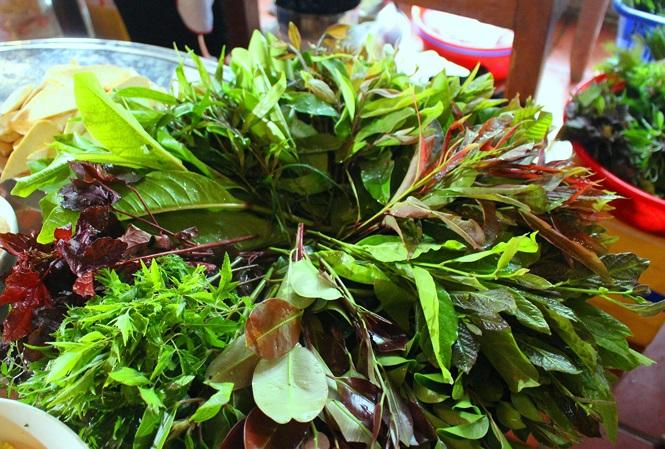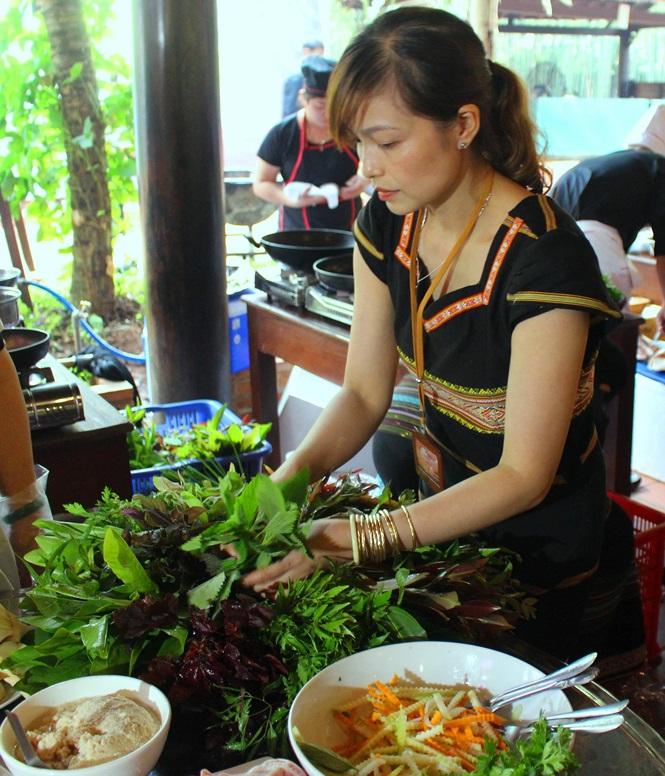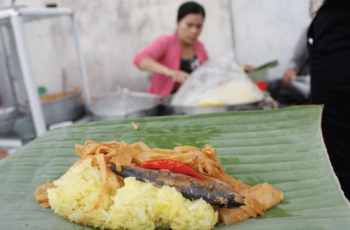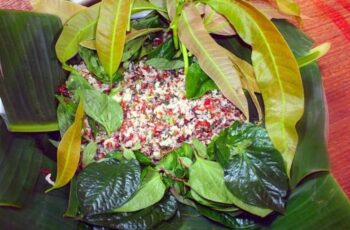Ad Blocker Detected
Our website is made possible by displaying online advertisements to our visitors. Please consider supporting us by disabling your ad blocker.
The Central Highlands is not only a majestic mountainous region, home to a gong cultural space recognized by UNESCO as a masterpiece of intangible culture and oral tradition of humanity, but also ethnic minority cuisine is a part of the culture. Central Highlands, becoming one of the factors that attract tourists. The traditional dishes of the people and unique processing methods bring the flavors of the mountains and forests, giving local people a great source of income.
 Leaf salad has nearly 60 types of leaves
Leaf salad has nearly 60 types of leaves
The rustic dishes in the daily meals of the Ede, M’Nong, Gia Rai people… are made from wild plants and vegetables growing along the roadside or on the fields, and are considered the quintessence of the great forest. Specialties are popular with tourists.
Taste of the forest
A close friend from Vinh city came to “travel” to the Central Highlands. She said she knew the Central Highlands with its mysterious wildness and the nights resounding with gongs. When reading the ethnographic research book “We Eat the Forest” by French ethnologist Georges Comdominas, he described the close connection of the ethnic groups residing in the Central Highlands, specifically the M’Nong people, with the forest. What makes her curious and want to explore Central Highlands cuisine?

Ms. H\’Sor shares how to make leaf salad
At noon, the tray is full of leaves with all shades of green, young green, dark green to purplish green of all kinds of young leaves. Next to it are dishes with thinly sliced pork belly, boiled shrimp, shredded pork skin mixed with finely crushed galangal, a plate of whole pepper, salt and chili pepper, and a bowl of thick yellow dipping sauce. Ms. H’Sor, owner of a restaurant in Kon Tum, shared: People who eat this leaf salad for the first time will be very confused, eating leaf salad is as simple as eating salad. This dish must be done by hand to be authentic. Kon Tum people eat leaf salad all year round. In the dry season, you can only find 30-40 types of leaves, while in the rainy season, you can get nearly 60 types of leaves for the salad plate. Many restaurants and eateries here rely on the indigenous people’s skill of going to the forest to pick leaves to create a full range of colors and flavors.
My friend continued, in the breeze of the Central Highlands monsoon, when eating this specialty leaf salad, she imagined the deep green forests, truly the taste of the mountains and forests. After a bit of hesitation, she said, looking at the many strange leaves she was seeing for the first time. Recently, I read in the newspaper that a family outside Bac Kan had guests. The homeowner went to pick wild vegetables to cook soup for the guests, but picked the wrong leaves, causing the guests to be hospitalized after eating. It’s scary to say the least.
Ms. H’Sor smiled and continued: The leaf salad in Kon Tum was introduced nearly 25 years ago. Since ancient times, indigenous people of the Central Highlands have used leaves picked from the forest in their daily meals. They eat instead of rice when they go to the fields. The leaf salad is the essence of indigenous cuisine. Many people worry about the safety of this dish, however, each type of leaf is selected very strictly, the most important thing is that they are not toxic, do not react with each other, wild leaves are experienced from Thousands of generations of indigenous people, each type of leaf contains nutrients, has good effects on health, making it a unique salad today.
There is no dish that takes as long to get bored as leaf salad, which is what gives the unique leaf salad its strange appeal. Must go to Kon Tum, where the clear blue Dak Bla river curves at the foot of the mountain. The majestic Ngoc Linh has many legendary stories to fully feel the very unique, very highland taste of this leaf salad.
Food to relieve hunger
The rain soothes the harsh sunlight of the dry season in the Central Highlands, the sky is a deep blue color with soft melodious music from the traditional stilt house of the M’Nong ethnic group (Ja village, Hoa Son commune, Krong Bong district, Dak Lak) with a peaceful scene when the man diligently plays the gong, the woman passionately pounds leaves to cook soup.
Mr. Y Quyet Lieng (born 1961) smiled kindly: The M’Nong people like to live on hillsides and forest edges near streams and small creeks. Life is peaceful with the sowing and harvesting seasons, growing potatoes and cassava on the fields, hunting and gathering in the forest, and catching fish and shrimp in the stream. Life mainly relies on nature, is protected by nature, and then M’Nong culture is affirmed from there.
Through each dish of the people, diners will feel the Central Highlands through each leaf. For each ethnic group, there will be a few main types of leaves to prepare into many dishes. The traditional dish of the M’Nong people is thut soup, a simple dish close to nature, very good for health, it is a mixture of sweet and bitter flavors… The ingredients are wild vegetables. of the mountains and forests of the Central Highlands, growing everywhere on the fields and at the edge of the forest are bep leaves (also known as waterweed), rattan shoots, bitter eggplants, and a number of other vegetables and stream fish.
The bamboo tube is the ingredient that creates the unique flavor of Thut soup when the ingredients are put on the stove to cook until soft. Today, bep leaves still grow naturally quite a lot in Dak Lak and Dak Nong provinces. This is a type of leaf with high nutritional value. Prepared into many dishes: crab soup with bep leaves, bep leaves stir-fried with rattan shoots, canned fish… now it is not only a traditional dish in the villages of the M’Nong people, but has entered many restaurants in the Central Highlands to be introduced. with diners near and far.
In the middle of the stilt house of the Ede people, with a pot of steaming hot soup, Mrs. H’Nhing (Ea Tar commune, Cu Mgar district) prepares dinner for the whole family, saying: This bitter eggplant soup is now not only of the Ede people and has become a favorite dish of Kinh families in the city. When first eating eggplant, the bitter taste of eggplant makes the eater uncomfortable, but the aroma and fleshy taste pull the taste buds very strongly, gradually you will feel the residual sweetness on the tip of the tongue.
The Ede people live in harmony with nature, so spicy and bitter flavors have been a choice since ancient times for people to adapt to their living environment. These two flavors make food delicious, increase resistance, and fight diseases. Bitter tomatoes are an important ingredient in the culinary culture of the Ede people. In the past, bitter eggplant grew at the foot of hillsides and in fields like grass. Later, the Ede and Kinh people brought it to their gardens and planted it as a food crop. Compared to plants grown in home gardens, bitter eggplants growing wild in the forest have smaller fruits and a stronger bitter taste. Now bitter eggplant is on the menu of tourist restaurants and is processed into many dishes such as bitter eggplant with dried fish, sunflower eggplant cooked with eel, frog…
Leaf salad in Kon Tum province is considered the quintessence of the Central Highlands with nearly 60 types of leaves growing on Basalt red soil. Leaf salad was recognized in the top 10 Vietnamese specialties with Asian culinary value for the second time in 2013, bringing diners closer to Central Highlands culinary culture.


